Primary Treatment In a Successful Orthopedic Clinic: The GYROTONIC® Method and the GYROKINESIS® Method
Blog Content Testimonial // October 26, 2017
We visited the Rheintal Clinic and talked with three of the Physiotherapists working with patients there to hear what they had to say about integrating the Gyrotonic Method and the Gyrokinesis Method into their treatment programs.
This facility is a large, specialized clinic for orthopedic traumatology and internal medicine and cardiology and is located in Bad Kronzigen, Germany. It was the first clinic of its kind in that area to include the methods as part of their primary modes of treatment in their therapy programs .
The Rheintal Clinic was first introduced to the methods in the early ’90s by Paul Horvath, brother of the creator and founder of these methods, Juliu Horvath. To this day, Gyrotonic and Gyrokinesis exercises are an essential part of the patient pre- and post-rehab protocols prescribed by the clinic physicians.
Thomas Wolburg
Physiotherapist/Head of Physical Therapy at the Rheintal Clinic
Athletic Trainer
Gyrotonic Master Trainer
We’ve been incorporating the Gyrotonic Method and the Gyrokinesis Method here for more than 20 years. Paul Horvath asked us if we wanted to try something new. Paul is a physiotherapist with a lot of knowledge from sports and therapeutic movement, and he is the brother of Juliu Horvath.
Before Paul came, we were focused mostly on manual therapy and osteopathy. Sometimes we still use these techniques, but only in support of the whole system. With manual therapy alone, you have a patient lying down, and you do some manual work, hoping that something is working, or that something is going on.
Now, we do manual therapy and osteopathy in conjunction with movement. This allows us to better see what is happening, which is the difference between passive treatments and active treatments. With passive treatments, where the therapist does all the moving of the body for the patient, the therapist gets tired and the patient may, or may not, feel any noticeable results. Both are disappointed then.
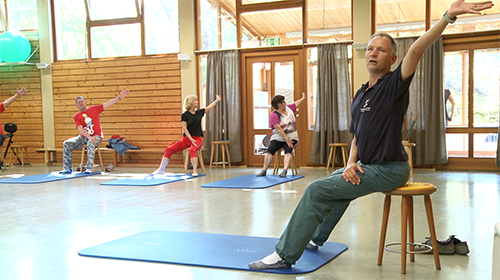
Photo provided by Gyrotonic International Headquarters
With the Gyrotonic and Gyrokinesis Methods, we bring the patient into the work. They move and learn how to know their own bodies, so that they can become responsible for their own bodies. This work is the best system for a person to gain more body awareness.
Originally, we were introduced to the Gyrokinesis Method, which does not require equipment. Then, the first machine — one of Juliu’s big, handmade pulley towers — arrived at the clinic in 1996.
At that time, using this work in the clinic was not planned by the doctors. So we just incorporated it as “exercises,” rather than calling it by a name. We did this because with something new like that, you have to continually try and explain to everyone what it is. It became quite a lot to try and tell so many people again and again, so we just incorporated it with the physical therapy and continued working. Eventually, all of the people in the clinic began to understand what the work was.
Step by step, and over the years, more and more members of our team became interested in the system. At this clinic, we now have one Gyrokinesis master trainer, three Gyrotonic master trainers, one Gyrokinesis pre-trainer, and sixteen regular Gyrotonic trainers. Everyone now knows what this work is. Doctors often ask that we do the work with patients because they know it and understand how effective it is.
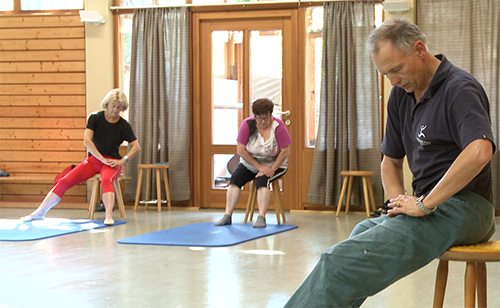
Photo provided by Gyrotonic International Headquarters
We have about twelve Gyrotonic machines in the clinic, and we offer the treatment of a one-hour Gyrotonic or Gyrokinesis class. These classes are adapted from the original formats, because we are working with many physical restrictions and we have to modify the exercises.
At the same time, we also offer 30-minute Gyrokinesis classes for basic spinal motion work. We also do Gyrokinesis exercises in the water using things like water noodles for support.
You have everything in this system. You have smooth movement; you have a stop wherever you want to have a stop; you have guidelines and methodology from simple day-to-day tasks all the way to sports activities. It is not just a collection of disconnected exercises. This work is a whole system where one part is supporting the next part and so on. Everything comes together to help better the person. The patients feel this, so they come back to do this work, even paying out of pocket, outside of insurance.
The Gyrotonic and Gyrokinesis Methods are helpful for anyone who is able to move. Moving should be the way to be better. There are only some illnesses where you can’t move and you can’t start the process. In those cases, maybe they have to do something else first to start the progress, like breathing. Everyone knows how to breathe. This starts everything. We then move from breathing to movement, to more and more control, and then on to more and more movement.
We have a great mixture of patients here, with a great mixture of issues. This is why I know that the Gyrotonic work is effective. In a group you can have a young person with a herniated disc next to a 78-year old person, both benefiting from the work because they are both connected in their own bodies.
You need a lot of practice to see and feel what you can do with various people dealing with various issues. To bring them to the first step where you see what is most needed in order to help them is not something you can get from books.
With the great work of Paul, and his ability to show us how to incorporate and adapt this work for the clinic, we have been able to have programs specifically designed for the shoulder girdle, for people with herniated discs, for the pelvis, etc. Everything done in this clinic now has some element of the Gyrotonic or Gyrokinesis work.
Paul Horvath
Physiotherapist
Athletic Trainer and Gymnastic Coach
Course Creator: Gyrotonic Applications for Pelvic Girdle; Gyrotonic Applications for the Shoulder Girdle; Gyrotonic Applications for Scoliosis
It’s a long story of how I brought the Gyrotonic Method and Gyrokinesis Method to the Rheintal Clinic, but I will try and shorten it. The essential part is understanding the work that Juliu and I were doing individually, before he immigrated to America and me to Germany.
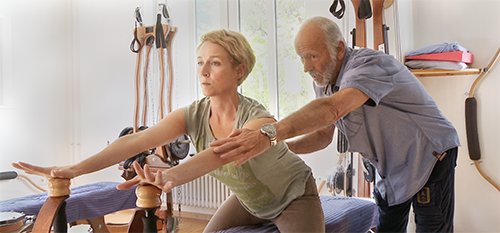
Photo provided by Gyrotonic International Headquarters
We come from Romania. There, I was a young gymnast, and Juliu was in ballet. I continued on in sports, he with ballet. However, we had a common experience with movement.
Once Juliu immigrated to the U.S., I did not see him for 20 years. We had only a few phone calls and short letters.
During our time apart, there were big developments for us both. He developed himself in yoga and energetic experiences, especially with the “Yoga For Dancers.” My experience continued on in gymnastics and sports performance.
When we finally reconnected, I was able to understand what Juliu was doing and what he was developing. Because of my own movement experiences, I had a deep understanding and sense of how the Gyrotonic and Gyrokinesis movements were biomechanically, energetically, and biologically important and unique to anything else.
In 1991, when I immigrated to Germany, I had my first real contact with Juliu’s Gyrotonic machines. While I had an idea of where things were going with the work before this, I was now able to see in reality how this had all developed, even beyond what I knew from the Gyrokinesis movements. It wasn’t like functional gymnastics; it was totally other movement patterns.
I went on for physiotherapy training in Germany. After completing that, I was fortunate to start working right away at the Rheintal Clinic. I was living in Freiburg, Germany, and the clinic was only twenty minutes from me in Bad Krozingen.
At that time, Juliu’s work was only in my head. No one here knew what it was. It was also very new in America at that time; it was just Juliu and his studio in New York City.
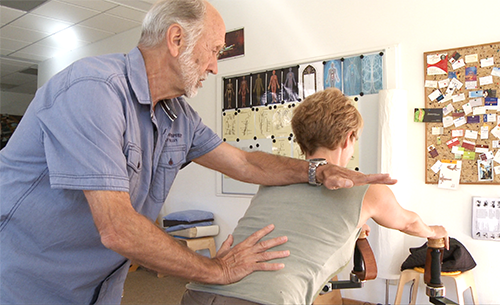
Photo provided by Gyrotonic International Headquarters
Two main factors contributed to this work becoming more well known here. First, the head of the Rheintal Clinic wanted to have something new, efficient, and effective to give the clinic a bigger position amongst other clinics around the Bad Krozingen and Freiburg area. I was in a good position to bring that.
Second, the coordinator of the physiotherapy department, Thomas Wolburg, was open to new things. So it was a very good time to talk about the Gyrotonic Method and the Gyrokinesis Method. I kept talking about it on a deep level until the possibility came about to bring a machine into the clinic, and work with people in the context of therapy.
For me, it was also new. I only had an idea of what would happen in a therapy context, but now I had an opportunity to have clinical experience with it. Over four or five years of activity and observation clearly showed how the Gyrotonic work can be applied in therapy.
The Rheintal Clinic is primarily an orthopedic clinic. There is also cardiology and internal medicine, but basically it’s more of an orthopedic clinic. Many clients who come here have orthopedic or somatic deficits, not necessarily organic deficits. For this, movement is generally the best healing.
But all movement is not equal; like when you compare technical movement, like bicycling or running, to Gyrotonic exercise, it’s not the same. This was already in my head from before when experiencing movement with Juliu in New York.
Step by step, I began to apply this work, eliminate my own deficits, and ultimately get better and better at teaching and helping people in therapy. You have to help them open physical restrictions, begin to feel more comfortable in their bodies, and in general learn how to feel better. Most people are able to immediately see how beautiful the movement is and feel the benefits.
Ingrun Wolburg
Physiotherapist
Athletic Trainer
Gyrokinesis Master Trainer
I’ve been working in this clinic for 27 years as a physical therapist. The groups dealing with spinal issues used to use something called isometric exercises. About the time Paul came to us, I had recently had surgery for my throat. I was, myself, very unbalanced and unstable. Paul introduced us to the Gyrotonic equipment and I tried it. I quickly realized that this was very beneficial to me and my health, and we should be offering this to our patients.
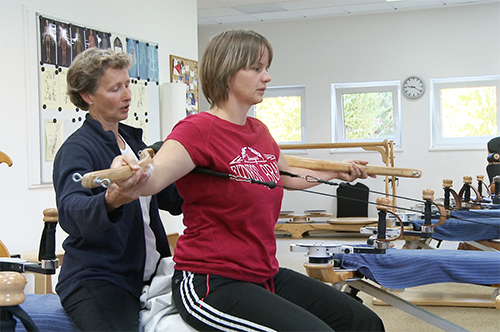
Photo provided by Gyrotonic International Headquarters
I started working with a woman who was 80 years old. We were lucky, because at this time Juliu and Paul were coming to the clinic teaching us.
At one point, Juliu was teaching a Gyrokinesis class and I tried to bring my elderly client with me. At first I thought she should only observe the classes. Then, she started to move and began having so much fun with it! After that, I started teaching many elderly patients.
I first start patients with movement. I want to see what is possible for them in active treatment. If it’s too much, than I explore the passive treatments like osteopathy or manual therapies. For me, though, it’s very important to bring the movement first, and then go step-by-step. This system allows me options for any patient.
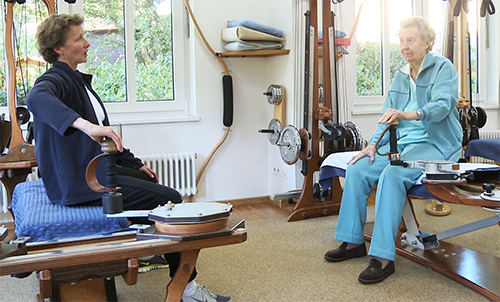
Photo provided by Gyrotonic International Headquarters
I have clients that come for prevention, and pre- and post-surgery. Sometimes they do this work and are able to keep their bodies healthy so they don’t have to have surgery.
We also have people who come for rehabilitation simply because they are not moving well in retirement. It’s great to see them start to brighten up, move, breathe and feel better.
I currently have a client who is 91 years old. She has been coming for 13 years. She started in a small Gyrokinesis group, and then moved to Gyrotonic classes. She loves this movement system and even moves at home with the exercises she can remember. She currently has eight stints, and the doctors want to do another operation. She does not want to do this, so she is trying to do this work to see if she can go without. In the last 10 years she has aged, of course, but she still drives, walks with a walker, and cooks for her family at home.
We need more physical therapists that are Gyrotonic teachers. Too often, physical therapy students have too much anatomy in their heads. They learn that therapy is only focused on moving this joint or that joint, and dealing with this one symptom.
With the Gyrotonic work, we work on the whole body so that step-by-step, as the whole body moves, the joint gets better. Of course, if there was a big shock like an accident of some kind, then I must start osteopathy. Most of the time, though, I can start with moving.
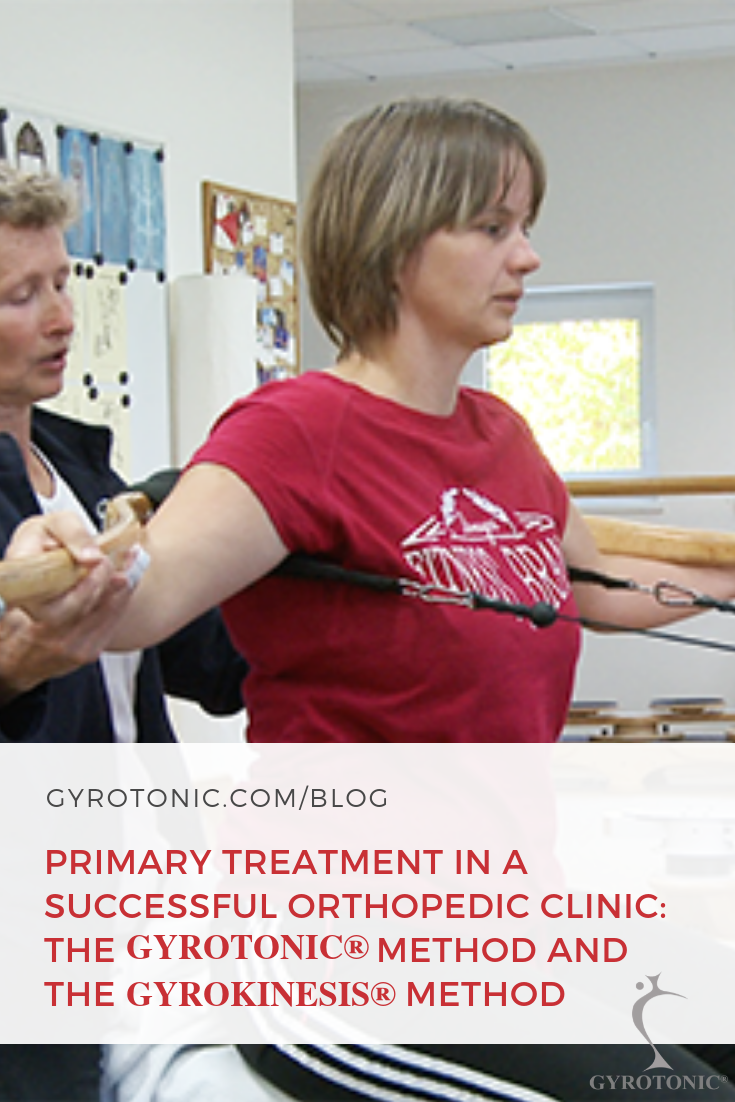
Pin for later!

hello; i have big herniated disc and i’m waiting for the surgery. i am in lot of pain. do you think i could do gyrotonic, one month after surgery? or this is counterindicated and i could do harm on my disc? thanks!